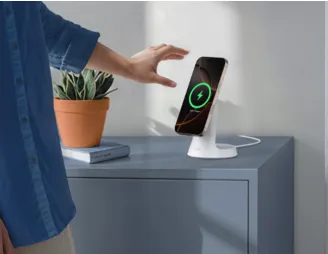MagSafe technology, initially introduced by Apple for the iPhone 12 series, has revolutionized wireless charging by offering a magnet-based solution that ensures efficient and stable power delivery. But the question always arises: can Android users take advantage of this magnetic charging technology as well?
While MagSafe is primarily designed for iPhones, some Android phones can indeed benefit from its features—albeit with certain limitations. Below, we’ll explore how MagSafe Android charging works and what you should keep in mind if you’re considering using this technology with your Android device.
Understanding MagSafe Compatibility for Android Phones
Let’s look at the factors that determine whether you can charge your Android phone with a MagSafe charger, and what to expect if you decide to give it a try.
1. Basic Wireless Charging Compatibility
The key to charging an Android phone with a MagSafe charger lies in basic Qi wireless charging compatibility. MagSafe technology is built on the Qi wireless charging standard, which is widely used by both iPhones and many Android phones. If your Android device supports Qi wireless charging, it will work with a MagSafe charger, but without the magnetic alignment features. This means that while your phone can receive power, it won’t magnetically snap into place like a MagSafe-enabled iPhone, making the connection less stable.
2. Magnetic Compatibility Considerations
For magsafe android charging to work efficiently, your Android phone needs to have a magnetic component on its back. This is where most Android phones fall short because they aren’t designed to align with the MagSafe’s magnetic rings. However, a workaround involves using a third-party MagSafe-compatible case or magnetic ring that can be attached to the back of your Android phone. These accessories can mimic the MagSafe experience, providing a more secure connection to the charger.

3. Charging Speeds and Efficiency
Using a MagSafe charger with an Android phone might result in slower charging speeds. Apple’s MagSafe chargers are optimized to deliver up to 15W of power to iPhones, but the same speed isn’t guaranteed for Android devices. Depending on your phone’s Qi compatibility, you might only receive a lower wattage, such as 5W or 7.5W, which can lead to longer charging times. If fast charging is a priority, it might be better to use a charger specifically designed for your Android phone.
4. Impact on Battery Health
Using a MagSafe charger that isn’t optimized for your Android phone can potentially affect battery health over time. If the magnetic alignment is not perfect, it can cause slight overheating, which may degrade the battery’s capacity in the long run. For those who want to maintain the longevity of their Android phone’s battery, using a native wireless charger or one specifically rated for their phone model is recommended.
5. Accessories to Make MagSafe Work for Android
Fortunately, there are third-party accessories that bridge the gap between Android phones and MagSafe technology. You can find MagSafe-compatible magnetic rings, adhesive mounts, and cases that transform your Android phone into a MagSafe Android device. This way, your phone can magnetically attach to a MagSafe charger, offering a more secure and convenient charging experience. While the speed and stability may vary, it’s a viable solution for those who want the benefits of MagSafe without switching to an iPhone.
Conclusion
While you can technically use a MagSafe charger with Android phones, the experience isn’t as seamless as it is for iPhones. Basic Qi charging will work, but without the added benefits of secure magnetic alignment and optimized charging speeds.
If you’re willing to invest in a few accessories, you can make MagSafe Android charging a functional reality, but keep in mind the limitations and possible impact on battery health. For now, it’s best to weigh the pros and cons before deciding if a MagSafe charger is the right choice for your Android device.
